today's work
Collapse
X
-
-
HIya David! I'm building the Arkmodel Type VII; almost to the point where I get to install the dive system. I have 2 boats on the side; an Akula II form Scaleships and that Bronco Type XXIII. Retirement from the rat race is less than 4 months away, so I'm hoping to get more engaged in my carving and model building. The SubFest sounds like a great meet, and not too far away..
Last edited by goshawk823; 11-20-2021, 12:35 PM.Comment
-
Comment
-
On real submarines the areas of deck (and sail planes in this case) that get foot traffic receive a coating of a very course, crushed rock-binding resin paint called 'non-skid'. The rough texture of this 'non-skid' paint, though almost always over-painted with hull black, tends to bounce light in a way that at almost any angle the non-skid portions of hull appear to be a shade lighter than the surrounding black.
And that's the off-shade of the hull black used to represent the non-skid areas on a model. Below is a shot of the non-skid dark gray applied to both the upper deck of the submarine as well as the top portions of the sail mounted fairwater planes.
As future work to weather the model will require re-masking of the non-skid areas, the specially cut masks used to achieve the demarcation lines between hull black (actually a very, very, very dark gray) and non-skid gray will be needed later, so they are preserved on this scrap piece of Sentra sheet.
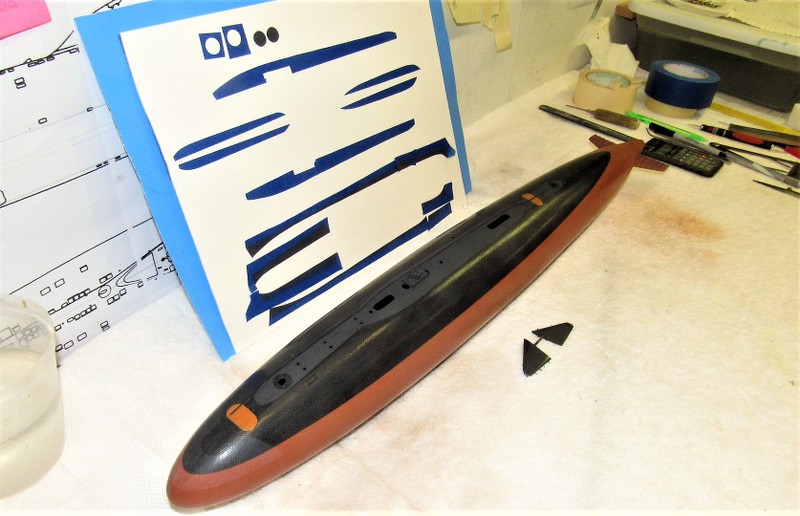
Clear plastic sheet stencils (being clear its a simple matter of tracing their outlines over a scale plan-view of the subject) were cut to shape. These stencils would guide my knife as I cut the low-tack masking tape counter-mask and mask proper used to define the line between non-skid and black. The counter mask elements were further divided longitudinally into halves, this done so I could place them dead-center atop the deck. The purpose of the centered counter-masks is to guide me as I butt the edges of the mask proper elements up against the outboard edge of the counter-masks. This method insures symmetry of the masked outlines.
For clarity I've pulled the masks back a bit from the counter-masks so you can more easily see that one set of masks is the mirror of the other. Of course, after this shot was taken, I relocated the masks up tight against the counter-masks. You can just make out the deck and fairwater plane clear stencils bottom, left.
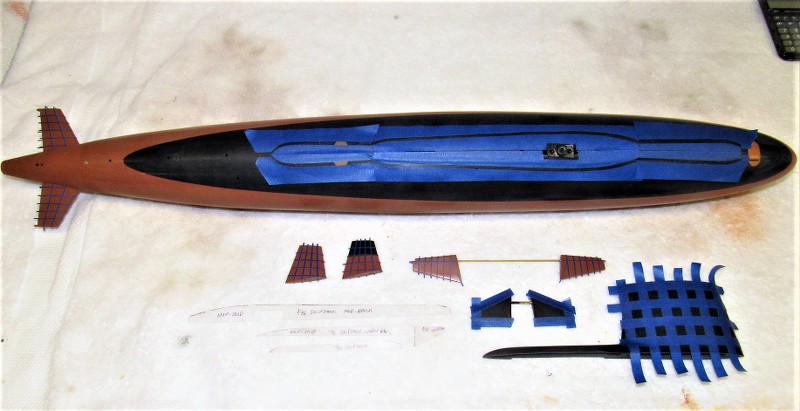
With the outboard masks butted up against the counter-masks all I had to do was remove the counter-masks -- taking care to save them for later use -- leaving those portions of deck that will get the non-skid gray exposed.
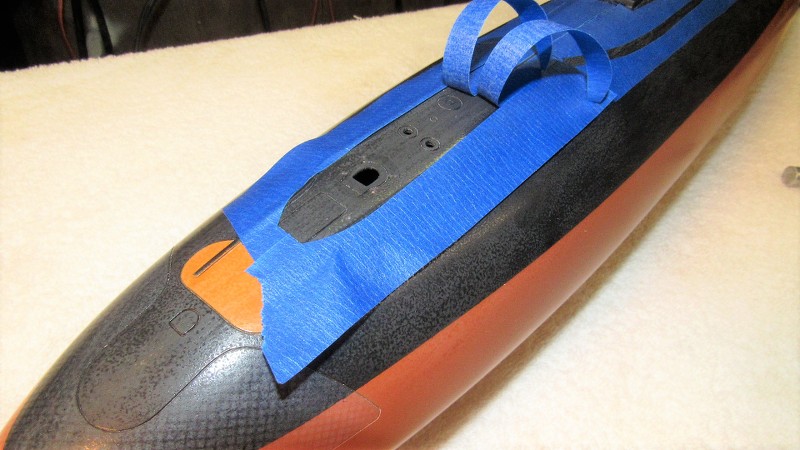
I've still got to mask out those portions of the aft 'international orange' marker-buoy, the top of the safety track, as well as the circular seating surfaces around the forward and after escape trunk McCann rescue bell/DSRV seating surfaces.

The circular masks were cut out of masking tape with simple circular punches. These are made from brass tube that have had an end beveled in and out to produce a knife-edge. Simply press the tool into the tape and, like a cookie-cutter, the tool produces a perfect round mask and counter-mask.
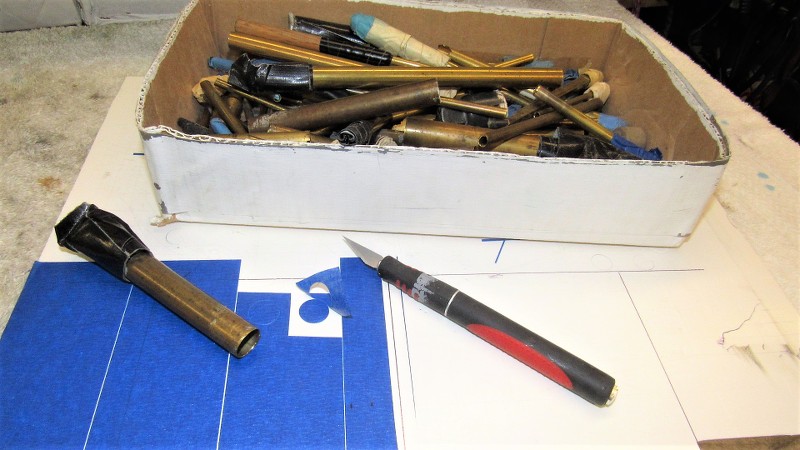
All masking in place I mixed up a slightly grayer version of the hull black. These days I use that cheap-ass Walmart water-soluble acrylic paint (a lot cheaper than that outrageously expensive crap you get from the hobby shop) for this kind of work. It's easy to prepare, is very easy to clean the brushes and air-brush after use, and dries almost immediately when pushed a bit with a hot-air gun. In this shot you'll note that I've added more pieces of masking tape to ward against any over-spray from getting to places I don't want it. Tape is cheap, fixing over-spray mistakes is aggravating!
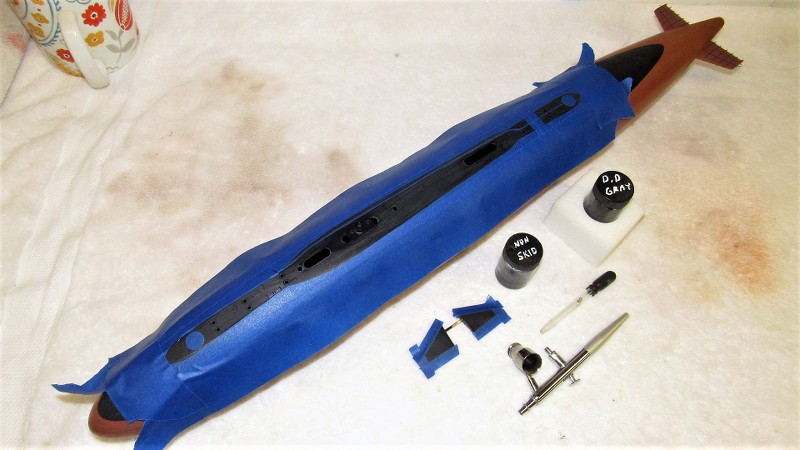
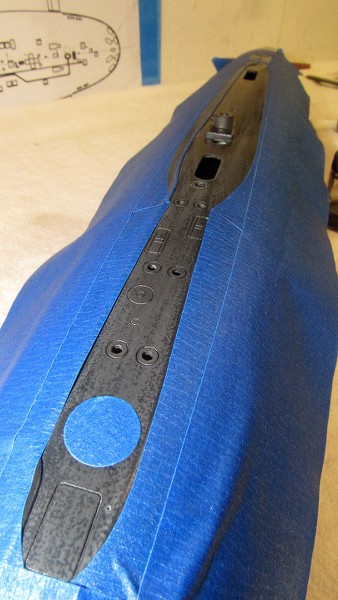



Laying down the anti-skid gray.
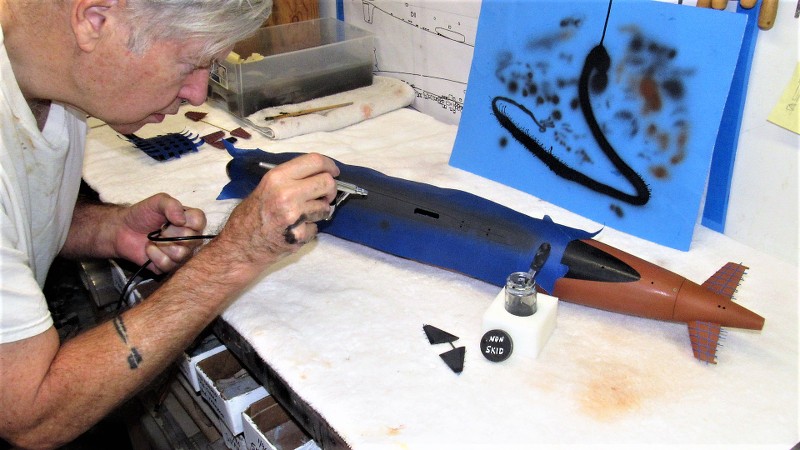
Masking removed and saved for later use. The non-skid and black areas of hull are now ready for weathering. More on that later.
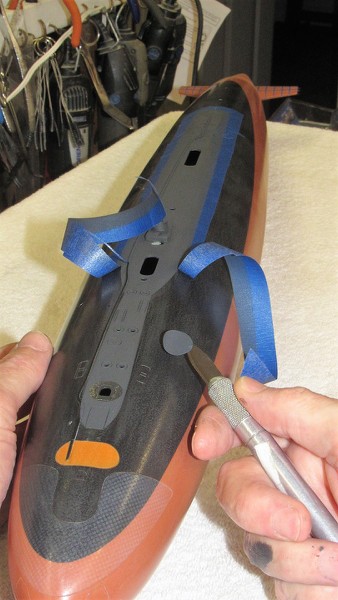
DavidWho is John Galt?👍 2Comment
-
Comment
-
-
With the deck and sail plane non-skid gray applied, the two remaining tasks were to represent the slight metal plate dishing of the control surfaces and horizontal stabilizers (the dishing of the sail would come later), and scuffing of the non-skid surfaces by foot traffic.
The dishing, sometimes referred to as 'oil-canning' on the real thing, is due to the elasticity of steel plate (everything is elastic to one extent or another) which will, over time, dip inward slightly against the rigid under-structure of frames, ribs, bulkheads, strings and other such foundations upon which the plating is secured.
Light reaches our eyes when looking at such structures will change in color slightly from the convex-concave variances produced by the slight dishing of plate between under-structures. A model makers cheat is to vary, every so slightly, the color between the supposed high and low portions of the plating by tinting the base color ever so slightly and shooting it over the surface upon which narrow masking strips are placed, those strips over where the under-structure would meet the plating. The below shot illustrates the desired result: the suggestion of oil-canning.
A process to represent actual plate distortion... and advocated by the criminally insane... is to mask the high points and sand-blast within the masking. Works only if the entire structure is of one type substrate.
A rather grizzly fact: The source I used to find the pattern of such oil-canning on the SKIPJACK was examination of the relevant pictures of the sunken SCORPION The Mystery of the Sinking of the USS Scorpion (warhistoryonline.com) . All was revealed when that boat imploded: tremendous pressure pulses were created that physically distorted the plating to an extreme extent. See: 'explosive metal forming' Microsoft PowerPoint - explosive forming.pptx (hermeticsolutions.com). Anyway, that's how I worked out the pattern of dishing for the horizontal stabilizers, stern planes and rudders. I juxtaposed the layout for the sail planes to those of the stern planes.
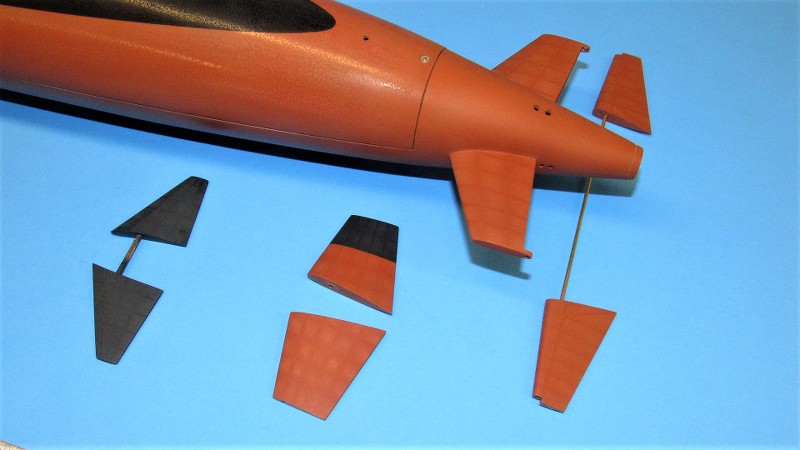
DuPont ChromaColor two-part, polyurethane automotive paint was used to achieve the base colors of dark, dark gray for the upper hull, sail planes, portion of the upper rudder, and sail; and the anti-foul red of the hull, horizontal stabilizers, rudders and stern planes. This system is a very tough chemical, UV, and abrasion resistant coating. Has to be. Its auto paint... duh! The only liability about this stuff is the care I have to take when cleaning the tools after a painting session as this stuff cures exothermically, and if I don't jump right on it after spraying I'll loose my precious spray-brush/gun. Unfortunately this wonderful stuff is no longer available. Rule of thumb: the more toxic it is, the better job it does of sticking and warding off damage.
(Now, god help us, the EPA, OSHA, and other goose-stepping federal and State agencies have foisted water-soluble paints on the automotive industry! I've lived too long -- thanks to California and the other tree-hugers, the good coating systems are no longer commercially available).
Anyway...
For the detail painting and weathering work I go to a more user friendly chemistry such as water-soluble acrylic paint, artist's oils, pastel chalks, colored pencils, and soft artist crayons, to name just a few of the agents I'll employ to give the model that 'used' look. These are not durable agents, but after their application the entire model will be give a protective ChromaClear coat that will be flattened down considerably to give the presentation the proper, uniform sheen.
You see here the mask marking stencils (for masking the non-skid areas of hull and sail planes); cutting board where strips of masking tape are cut to length; the ever reliable Paasche model-H air-brush; and a selection of base colors and tints of them needed to achieve the oil-canning effect.

The process for the appendages -- different for the sail, which will get it's own chapter -- is to cut out very narrow strips of low-tack masking tape and apply them across the face of an appendage, following the documentation that denotes the high points of the plating.
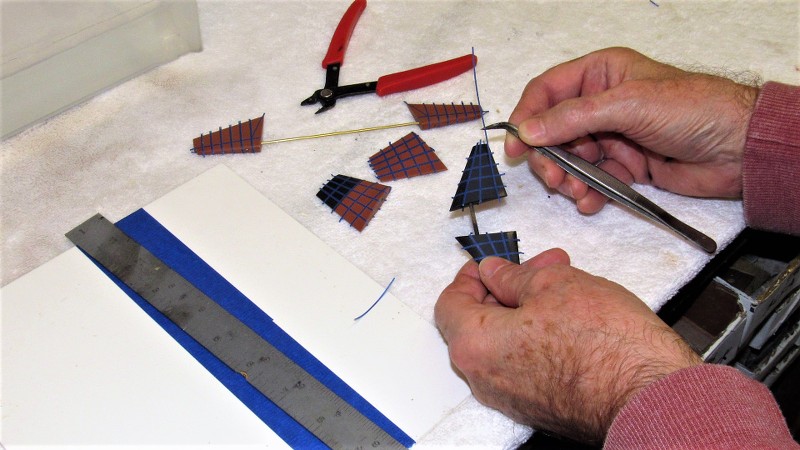
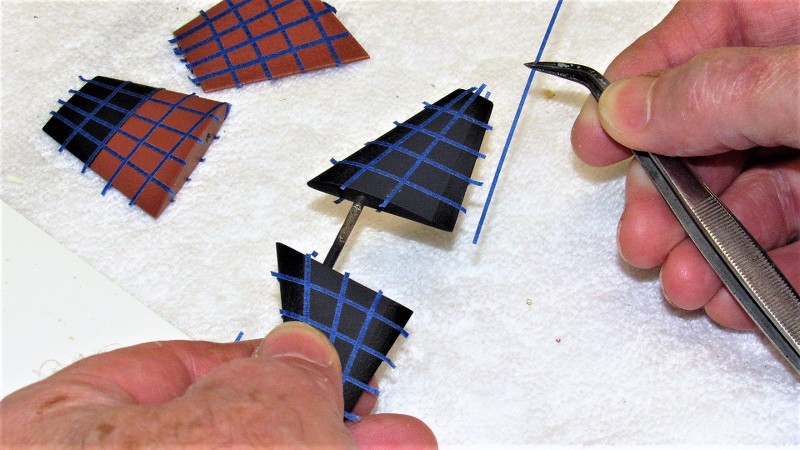
Then, as near the center of each 'square' as possible I gently blasted on a spot of toned down base color. In this case the anti-foul red. Here I've already done the rudders, and stern planes. And I just started
to remove the masking from the starboard horizontal stabilizer.

I'm using my ancient Paasche spray-brush with the #1 tip. Just right for this kind of work. Air pressure was dialed down to about ten-psi. As long as possible during the build I keep the control surface operating shafts 'wild', i.e. they can be removed easily. This so I can make use of a special handle which gives me the ability to move the work in relation to the spray-brush with ease.
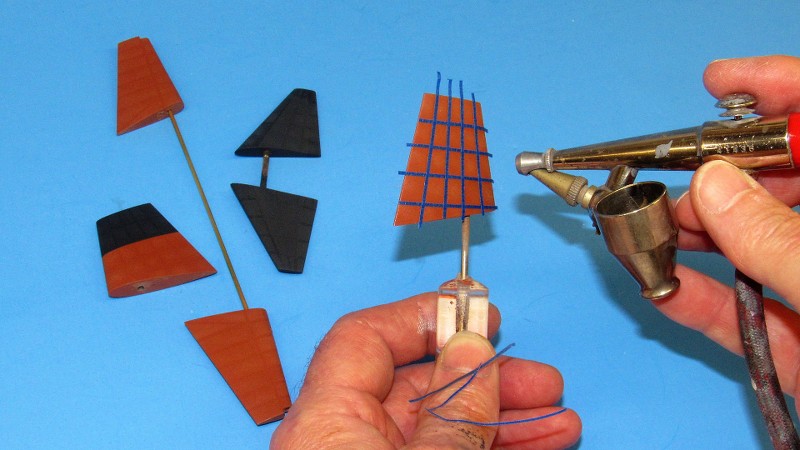
In the previous chapter I temporarily removed the deck non-skid masking to show off the work. Here I'm reinstalling it. An easy task; all I had to do was follow the painted on demarcation line between the lighter toned non-skid and the dark, dark gray hull, placing the inboard edge of the mask pieces right on the line. This in preparation to stippling on scuff-marks put there by people walking atop the hull and sail planes. A pristine model looks like a toy. One properly beat up and weathered looks real.
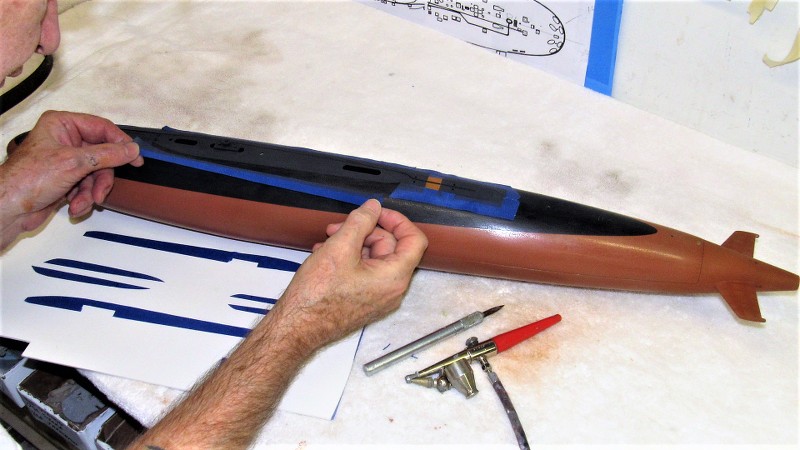
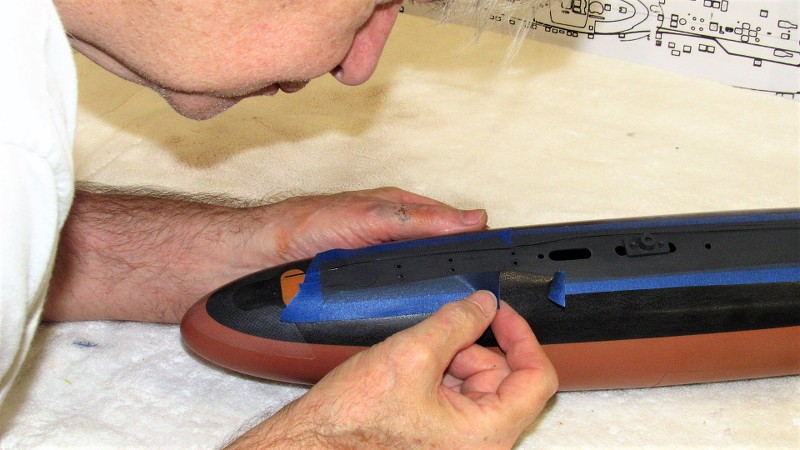
The non-skid gray was toned down with more white to stand out when stippled onto the surface of the hull and sail plane non-skid portions. At this point the scuffing is too distinctive and will be toned down in a few moments.
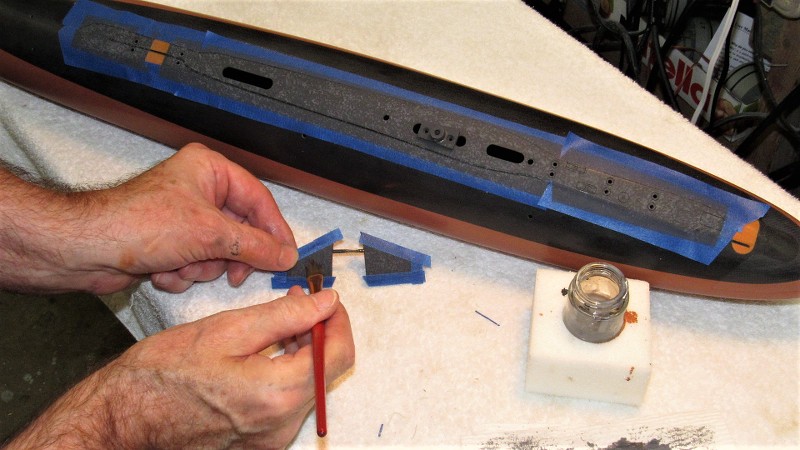
Notice the ragged ends of this poor paint-brush. It was selected for this stippling job just for the randomly splayed out brush hairs. A suitable stenciling brush. It is loaded with paint, which is then wiped out as best I can on a rage (to the right). There is some residual paint in the brush and that's all I need to get it on the model parts. No strokes of the brush, just gentle stabbing onto the work, the brush held at a right-angle to the work.

The over-stated scuff-marks were over-coated with a light misting of the base dark, dark gray to tone things down to an acceptable level. The same was done to the none-skid scuff-marks atop the sail planes.
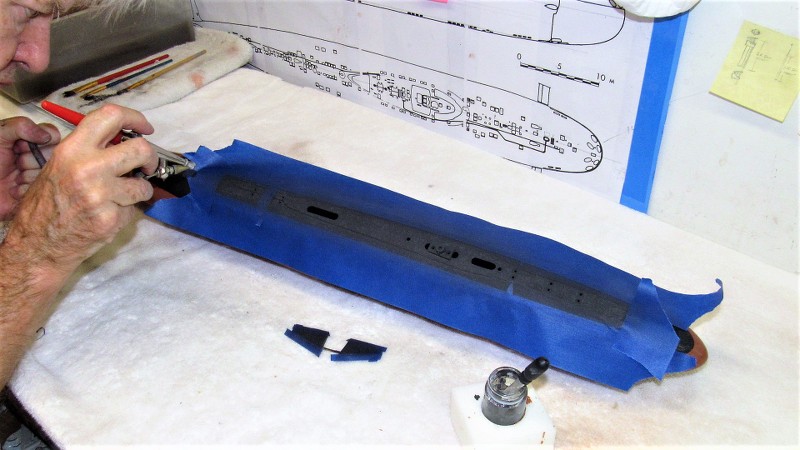
David
Who is John Galt?Comment
-
-
Comment
-
-
Comment




Comment